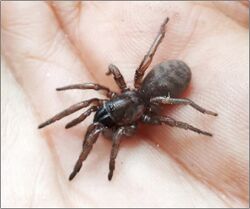Biology:Nemesia berlandi
| Nemesia berlandi | |
|---|---|

| |
| Scientific classification | |
| Domain: | Eukaryota |
| Kingdom: | Animalia |
| Phylum: | Arthropoda |
| Subphylum: | Chelicerata |
| Class: | Arachnida |
| Order: | Araneae |
| Infraorder: | Mygalomorphae |
| Family: | Nemesiidae |
| Genus: | Nemesia |
| Species: | N. berlandi
|
| Binomial name | |
| Nemesia berlandi Frade & Bacelar, 1931[1]
| |
Fagilde's trapdoor (Nemesia berlandi) or buraqueira-de-Fagilde in Portuguese, is one of the rarest animals on earth,[2] currently only known from Fagilde and the adjacent village of Vila Garcia,[3] both in the Mangualde municipality of the Beira Alta region of Portugal, in the isolated slopes of the River Dão valley.[1]
This species has not been scientifically recorded for nearly a century, since the first specimens were collected prior to 1931 for their scientific description,[1] and it is feared that the sole specimens known were destroyed in the great Bocage Museum fire of 1978.[4][5]
This species was described by the Portuguese science pioneer Amélia Bacelar and her husband, Fernando Frade.[1] The scientific name N. berlandi was chosen by the couple to honor their colleague Lucien Berland, from the National Museum of Natural History in Paris.[1] The common name is a reference to the site where it was originally found, in Fagilde.[1]
A unique attribute is that they build their nests horizontally unlike other species of trapdoor spider.[6] According to Re:wild, males of this species tap dance to attract mates.[6] This species is on Re:wild's Search For Lost Species, it became lost around 1931 and was rediscovered in 2023, using DNA to rule out other species in the region.[6]
Rediscovery and conservation
Trapdoor spiders are one of the conservation priorities for the International Union for Conservation of Nature,[7] and local efforts are underway to protect Fagilde's trapdoor.[6] In 2022 it was the only European species and the first spider, to be included in Re:wild's Lost Species list,[3] a project that selected the top 25 most wanted species in the world, as no record of Fagilde's trapdoor has been made in nearly a century.[3]
References
- ↑ 1.0 1.1 1.2 1.3 1.4 1.5 Frade, M. F.; Bacelar, F. (1931). "Révision des Nemesia de la faune ibérique et description d'espèces nouvelles de ce genre". Bulletin du Muséum National d'Histoire Naturelle. 2 3 (2): 222–238 [234]. https://www.biodiversitylibrary.org/page/55340918.
- ↑ "Aranha rara, "desaparecida" há 92 anos, redescoberta numa aldeia da Beira Alta". https://www.publico.pt/2023/12/19/azul/noticia/aranha-rara-desaparecida-ha-92-anos-redescoberta-aldeia-beira-interior-2074185.
- ↑ 3.0 3.1 3.2 "Re:wild's Search for Lost Species". http://www.rewild.org/lost-species/top-25-most-wanted-lost-species.
- ↑ "Museu Bocage / Um Museu Colonial". https://www.triplov.com/politecnica/fotos_museu_bocage/pages/a_incendio.htm.
- ↑ "A web of mystery: In search of the lost Fagilde’s Trapdoor Spider". https://www.rewild.org/news/a-web-of-mystery-in-search-of-the-lost-fagildes-trapdoor-spider.
- ↑ 6.0 6.1 6.2 6.3 "Lost tap-dancing spider rediscovered barricaded in a burrow in a small Portuguese town after 92 years" (in en). http://www.rewild.org/press/lost-tap-dancing-spider-rediscovered-barricaded-in-a-burrow.
- ↑ "The segmented trapdoor spiders, an EDGE species" (in en). https://www.iucn.org/story/202305/segmented-trapdoor-spiders-edge-species.
Wikidata ☰ Q2546121 entry
 |

